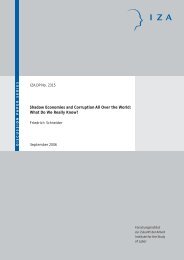Gender Differences in Education Tuomas Pekkarinen - Index of - IZA
Gender Differences in Education Tuomas Pekkarinen - Index of - IZA
Gender Differences in Education Tuomas Pekkarinen - Index of - IZA
Create successful ePaper yourself
Turn your PDF publications into a flip-book with our unique Google optimized e-Paper software.
6<br />
Years <strong>of</strong> <strong>Education</strong><br />
12<br />
7<br />
Years <strong>of</strong> <strong>Education</strong><br />
14<br />
Denmark<br />
1880 1900 1920 1940 1960 1980<br />
Birth Cohort<br />
Female Male<br />
Norway<br />
1880 1900 1920 1940 1960 1980<br />
Birth Cohort<br />
Female Male<br />
Years <strong>of</strong> <strong>Education</strong><br />
5 12<br />
6<br />
Years <strong>of</strong> <strong>Education</strong><br />
13<br />
F<strong>in</strong>land<br />
1880 1900 1920 1940 1960 1980<br />
Birth Cohort<br />
Female Male<br />
Sweden<br />
1880 1900 1920 1940 1960 1980<br />
Birth Cohort<br />
Female Male<br />
Figure 1: Female and Male average years <strong>of</strong> education by birth cohort and gender <strong>in</strong> the<br />
Nordic countries and <strong>in</strong> the United States. Source: Barro-Lee Data (2010)<br />
In Figure 1, I have plotted the average years <strong>of</strong> education by gender and birth cohort <strong>in</strong> the<br />
Nordic countries and the United States. Barro and Lee data allows one to exam<strong>in</strong>e the<br />
educational atta<strong>in</strong>ment from cohorts born <strong>in</strong> the late 19 th century onwards. 3<br />
Figure 1 reveals<br />
that <strong>in</strong> the United States men had higher educational atta<strong>in</strong>ment <strong>in</strong> the cohorts born between<br />
1920’s and 1940’s. However, <strong>in</strong> all <strong>of</strong> these countries, with the exception <strong>of</strong> Denmark, women<br />
caught up with men <strong>in</strong> educational atta<strong>in</strong>ment by the cohorts born <strong>in</strong> the 1950’s. After this the<br />
gender gap <strong>in</strong> average educational atta<strong>in</strong>ment has widened <strong>in</strong> favor <strong>of</strong> women. This widen<strong>in</strong>g<br />
<strong>of</strong> the gap reflects the fact that <strong>in</strong> most <strong>in</strong>dustrialized countries the growth <strong>in</strong> male educational<br />
atta<strong>in</strong>ment decelerated whereas female educational atta<strong>in</strong>ment kept on grow<strong>in</strong>g. This<br />
3 The Danish statistics for cohorts born after 1970 <strong>in</strong> the Barro and Lee data imply implausibly large drops <strong>in</strong> the<br />
level <strong>of</strong> educational atta<strong>in</strong>ment for both men and women. These data were not used <strong>in</strong> Figures 1 and 2 and this is<br />
why the Danish figures end with the cohort born <strong>in</strong> 1970.<br />
5<br />
Years <strong>of</strong> <strong>Education</strong><br />
12<br />
6<br />
Years <strong>of</strong> <strong>Education</strong><br />
14<br />
Iceland<br />
1880 1900 1920 1940 1960 1980<br />
Birth Cohort<br />
Female Male<br />
USA<br />
1880 1900 1920 1940 1960 1980<br />
Birth Cohort<br />
Female Male<br />
6
















